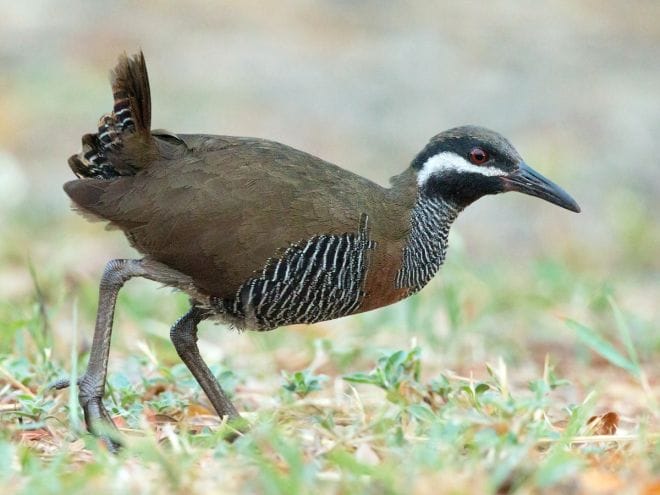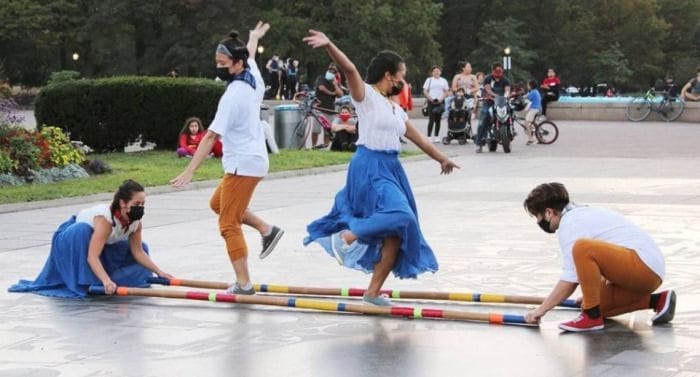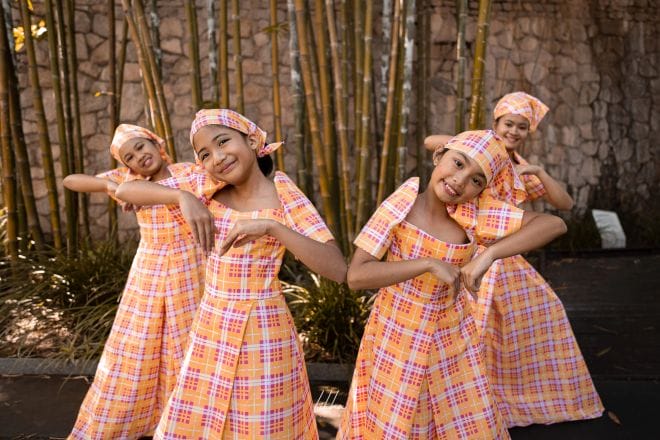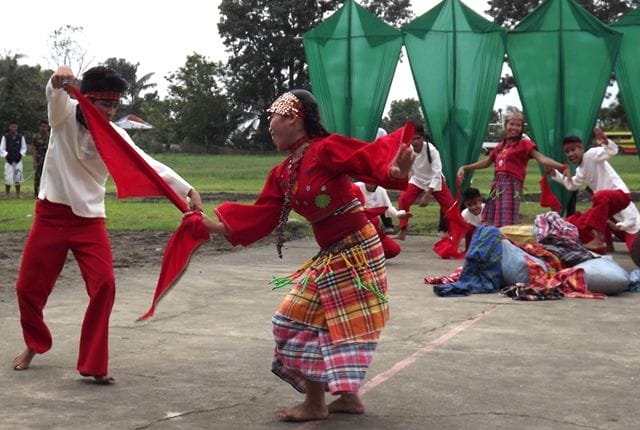By Ana Gabrielle Alcantara
The impact of the environment on people is well-known and Filipinos are particularly attuned to their surroundings and continually draw inspiration from them. This is evident in the way that the country’s natural landscapes, features, and biodiversity are deeply ingrained in its myth, folklore, tradition, and culture.
This article specifically highlights the origin of mimetic bird dances in Philippine culture and showcases how they reflect the deep connection between people and the natural world.
Tinikling (inspired from rails)
Considered as one of the most famous Philippine folk dances, Tinikling is named after the tikling or the rail bird. Originating from the Visayas region during the Spanish colonial era, the dance is said to be imitating the quick and agile movement of the tikling, which was considered an enemy to the ricefields, as it evades the bamboo traps set by local farmers to protect their fields.1
Performing the dance entails two performers, which represent farmers and their clappers, rhythmically tapping parallel bamboo poles on the ground and against each other. A pair of dancers step in and out of the poles barefoot, leaping and skipping with skill akin to the tikling that eludes capture from bamboo traps.1,2 Women typically wore a balintawak, a colorful dress with wide arched sleeves, or a patadyong, a loose pineapple fiber blouse paired with a checkered skirt. Men wore barong tagalog, the traditional formal wear for Filipino men, and red trousers.2,3 Musical accompaniment is usually a string ensemble, composed of bandurrias, guitars, and octavinas.3


Tinikling (National Dance of the Philippines)
A video showcasing the Tinikling dance performed by Filipino dancers.
(Video Credit: Dancing World, Youtube6)
Itik-Itik (inspired from ducks)
Originating from the Cantilan, Surigao del Sur of Mindanao, Itik-itik is a Philippine mimetic folk dance that imitates the movements of an itik or a duck. According to legends, it originated from a dance called sibay that was performed to the tune of Dejado. A young dancer named Kanang, who was considered the best in the Surigao province, was asked to perform during a baptismal party and got carried away with the rhythm. What resulted was an improvisation that was likened to duck behavior, with their choppy movements and splashing of water across their backs.7,8
This dance is usually performed in social gatherings by performers doing a series of short and quick footwork while their arms are bent forward at shoulder level and their fists closed together, emulating the flapping movements of a duck.5 Female dancers may wear a baro’t saya, patadyong or a balintawak with a bandanna around their heads. Male dancers can wear a colored neckerchief, barong tagalog and a camisa de chino, which is a collarless Chinese short-sleeved shirt worn underneath. This performance is played to the Dejado tune, with a rondalla ensemble serving as musical accompaniment.7


itik-itik instructional video
A video showcasing the Itik-itik dance
(Video Credit: Suzanne Keih Liwanag, Youtube11)
Kilingkingan (inspired from swifts)
Kilingkingan or kalingkingan is a dance popular in Cagayan Valley from Northern Luzon. It is inspired by the bird kalingkingan or swift which lives in caves and produces a distinctive sound when flapping its wings.12
This dance emulates the grace of the bird through various maneuvers, the gestures soft and dignified. What sets this dance apart from others is the use of wooden bamboo castanets to mimic the bird’s vocalization. Performers make use of two pairs of wooden bamboo castanets that when struck together produce sharp, crisp, and rhythmic clicking sounds reminiscent of kalingkingan calls.12


Kilingkingan by AES Dance Troupe
A video showcasing the Kilingkingan dance performed by the AES Dance Troupe
(Video Credit: KuyaSerLarry, Youtube15)
Binanog (inspired from hawks)
Binanog is a mimetic and courtship dance originating from Lambunao, Bukidnon. This dance is performed at the Binanog Festival in honor of the Sto. Nino every January. The dance attempts to replicate the banog or hawk in Cebuano. According to legends, Lambunaonons forefathers who lived in the mountains noticed that hawks were taking the chickens. They followed the raptors in the forests and became fascinated by the flight patterns of male hawks chasing the female hawks.12,16,17
The dance has three parts: Binanugan which imitates bird movement, Inagong Sayaw-Sayaw which is a celebratory dance and Dinagmay which is a courtship dance. Musical accompaniment mainly consisted of drums and gongs. The dance itself focuses on the accuracy and agility of footwork. Attires for this dance include a koton, a beautifully embroidered outfit worn under a saipan, a piña cloth shaped like a bell, or a sinombrahan, an embroidered cotton wrap.17


Binanog – Philippine Folk Dance
A video showcasing the Binanog dance.
(Video Credit: KuyaSerLarry, Youtube20)
Linggisan (inspired from frigatebirds)
Pangalay Linggisan is a dance from Sulu Archipelago, Mindanao which takes inspiration from its namesake linggisan, a Suluk word for frigatebirds.12,21 Unlike other dance forms that prioritize precise replication of bird movements, such as the Itik-itik, Linggisan places greater emphasis on the abstract and stylistic elements of bird motion. While performers don’t mindlessly flap their arms in literal imitation of the frigatebird, the aesthetic and grace of the curvilinear movements are more implicit.21
The kulintangan ensemble provides a melodic background and a constant rhythmic tempo as a solo female dancer creates smooth and flowing movements which emphasize controlled gestures from the hands, arms, elbows, and the asymmetric bodyline22. Metal claws called janggay are worn individually on each fingertip to accentuate hand movements. Inspiration from birds can be seen by the head movement imitating pecking movement as well as forming a bird head figure using the hands. Slow and deliberate arm gestures coupled with pulses of foot movement are a staple of this dance form.12,22


Traditional Tausug Dance: PangalayLinggisan
A video showcasing the Linggisan dance performed by the IngatKapandayan Artist Center of the Notre Dame of Jolo College (Video Credit: Pinas Muna, Youtube25)
Conclusion
Philippine folk dances are considered a symbol of the country’s identity. They reflect the customs, history, and beliefs of the Filipino people, and are highly valued for their portrayal of the nation’s rich cultural heritage. By participating in and being aware of these cultural practices, individuals can strengthen their values and preserve the knowledge of how dance can unite people.
Particularly, mimetic bird dances have been significant in Philippine folk dances. These performances not only showcase the creativity and ingenuity of Filipinos but also highlight the country’s diverse wildlife and environment. By preserving and continuing the practice of these dances, future generations can also benefit from the knowledge and cultural heritage passed down through the years.
References
- Buot, Merites M. “Dance movement analysis of Tinikling: a portrayal of an agrobiodiversity landscape.” Asia Life Science 21.1 (2012): 167-176.
- Valdeavilla, Ronica. “Tinikling: The National Dance of The Philippines with Bamboo Poles.” Culture Trip, 21 June 2018, theculturetrip.com/asia/philippines/articles/tinikling-the-national-dance-of-the-philippines-with-bamboo-poles/.
- Editorial Team. “TINIKLING DANCE, NATIONAL DANCE OF PHILIPPINES.” Dance Ask, 27 June 2022, danceask.net/tinikling-dance-philippines/.
- Irving, D. Barred Rail. 2013. Cornell Lab of Ornithology, ebird.org/species/barrai1.
- Harris, C. “All About Tinikling Dance: History, Characteristics, Steps & More.” Photograph. City Dance Studio, 2022, citydance.org/tinikling-dance-history-characteristics-steps/.
- Dancing World. “Tinikling (National Dance of the Philippines).” YouTube, 2018, www.youtube.com/watch?v=kckR6wf5xe8.
- Pangilinan, Math C., et al. “Asian Journal of Interdisciplinary Research| Volume 2| Issue.” Asian J. Interdiscip. Res 56.63 (2019): 56.
- Tomar, Kunal. “ITIK-ITIK DANCE – PHILIPPINES: A Dance Inspired by ‘movements of a Duck’ – DanceAsk.” DanceAsk, 21 Feb. 2022, danceask.net/itik-itik-dance-philippines/.
- SERD Personnel Editor. “Itik for Life Program for Sustainability of Philippine Duck Industry.” PCAARRD’s Industry Strategic Science and Technology Plans, 2022, ispweb.pcaarrd.dost.gov.ph/itik-for-life-program-for-sustainability-of-philippine-duck-industry/.
- Hiraya Performing Artists. hiraya.org.au/gallery/.
- Liwanag, A. “itik-itik instructional video.” YouTube, www.youtube.com/watch?v=hvSnYTaZIdg.
- sari.bon.sayaw.an. “SayawIbon / Mimetic Bird Dances.” Instagram, 2021, www.instagram.com/sari.bon.sayaw.an/.
- Irving, D. “Pacific Swift.” Photograph. eBird, 2017, ebird.org/species/fotswi.
- Dance Pinoy. “Kalingkingan.” DancePinoy.com, 2009, www.dancepinoy.com/2009/04/kalingkingan.html.
- KuyaSerLarry. “Kilingkingan by AES Dance Troupe.” YouTube, 2011, www.youtube.com/watch?v=cSdvj_3jqOU.
- Dacumos, J. “The Heart of Binanog Festival.” Vigattin Tourism, 2012, www.vigattintourism.com/tourism/articles/The-Heart-of-Binanog-Festival#:~:text=In%20their%20awe%20of%20watching,dance%20of%20love%20and%20courtship.
- Dance Pinoy. “Binanog.” DancePinoy.com, 2009, www.dancepinoy.com/2009/04/binanog.html.
- Pearce, Kevin. 2023, media.ebird.org/catalog?taxonCode=brakit1&mediaType=photo®ionCode=PH
- MybeautifulILOILO. “Binanog Festival: Fostering to Preserve Old Rural Traditions in Lambunao.” MybeautifulILOILO, 2016, mybeautifuliloilo.blogspot.com/2016/01/binanog-festival-fostering-to-preserve.htm
- Dance Pinoy. “Binanog – Philippine Folk Dance.” YouTube, 2022, www.youtube.com/watch?v=c2kZlUj1M4A.
- Quintero, Desiree A., and Mohd Anis Md Nor. “The Curvilinear Ethnoaesthetic in Pangalay Dancing among the Suluk in Sabah, Malaysia.” Wacana Seni Journal of Arts Discourse 15 (2016).
- Fernando-Amibangsa, L. “Pangalay: Ancient dance heritage of Sulu.” Inquirer.net, 2012, newsinfo.inquirer.net/247943/pangalay-ancient-dance-heritage-of-sulu.
- Roksana and Terry. “Lesser Frigatebird.” Photograph. eBird, 2018, ebird.org/species/lesfri?siteLanguage=en_PH.
- Tapales, S. “Dancing with Ligaya.” Positively Filipino, 2015, www.positivelyfilipino.com/magazine/dancing-with-ligaya.
- Pinas Muna. “Traditional Tausug Dance: PangalayLinggisan.” YouTube, 2013, www.youtube.com/watch?v=nc4fHGr2nTs.
